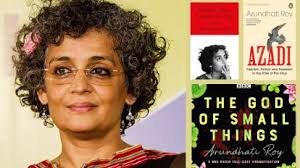A Guide to Reading Arundhati Roy: From The God of Small Things to Mother Mary Comes to Me

Acclaimed author and activist Arundhati Roy is set to release her much-anticipated memoir, Mother Mary Comes to Me, in September 2025. This book marks Roy’s first memoir, written in the aftermath of her mother Mary’s passing. Mary was not only an educator but also a fierce activist and a defining influence on Roy’s worldview. Early descriptions suggest that the memoir will be an intimate reflection on grief, love, and memory—while also continuing Roy’s lifelong exploration of how personal histories intersect with politics and freedom.
For readers new to Roy or longtime admirers wanting to revisit her work, here’s a comprehensive guide to navigating her literary and political journey.
The God of Small Things (1997)
Arundhati Roy’s literary career began with a groundbreaking debut. The God of Small Things won the Booker Prize in 1997 and became a global phenomenon, selling millions of copies. Set in Kerala, the novel tells the story of twins, Rahel and Estha, and the “Love Laws” that dictate who should be loved and how much.
The book’s lyrical prose, experimental structure, and heartbreaking narrative transformed Roy into a literary icon. Beyond its local setting, it resonates universally, capturing how societal structures and personal tragedies intertwine. Even after nearly three decades, it remains one of the most influential works of postcolonial literature.
The Ministry of Utmost Happiness (2017)
Two decades later, Roy returned to fiction with The Ministry of Utmost Happiness. Unlike her debut, this novel is sprawling, fragmented, and polyphonic—full of intersecting voices and shifting landscapes.
The story begins with Anjum, a transgender woman who makes her home in a Delhi graveyard. From there, Roy takes readers through the politics of Kashmir, the aftermath of wars, and the fragile lives of people pushed to the margins. Longlisted for the Booker Prize, the novel reaffirms Roy’s refusal to separate literature from political reality.
Where her first novel turned the personal into the universal, this second one situates the personal directly within turbulent historical forces.
My Seditious Heart (2019)
Beyond fiction, Roy is celebrated for her essays, which have cemented her reputation as one of the most powerful critics of power, both in India and globally. My Seditious Heart collects over two decades of her political writings—covering India’s nuclear program, environmental destruction, communal violence, and the impact of neoliberal policies.
At more than a thousand pages, the collection is as formidable as it is essential. It demonstrates Roy’s unwavering commitment to truth-telling, regardless of the backlash it provokes.
Azadi: Freedom. Fascism. Fiction. (2020)
Published during the COVID-19 pandemic, Azadi is a slim yet sharp collection of essays. It reflects on the rise of authoritarian politics, the erosion of democratic values, and the meaning of freedom in modern India.
The book, notably banned in Jammu & Kashmir, underscores how Roy’s work often challenges state narratives. In it, she continues to link literature with resistance, insisting that storytelling is itself a political act.
The Architecture of Modern Empire (2023)
In collaboration with journalist David Barsamian, Roy explores themes of war, nationalism, corporate power, and resistance movements. These conversations, spanning 20 years, provide readers with an accessible yet profound entry point into Roy’s political thought.
It is less a traditional book than a dialogue—an exploration of ideas that remain deeply relevant in an era of global unrest.
Things That Can and Cannot Be Said (2016, with John Cusack)
Though slimmer than her other works, this text packs urgency. Co-authored with actor John Cusack, it recounts conversations with Edward Snowden and Daniel Ellsberg—two figures central to debates about state surveillance, secrecy, and empire.
The book is a stark reminder of how global systems of power operate in secrecy, and how voices of dissent can illuminate hidden truths.
What to Expect from Mother Mary Comes to Me
With Mother Mary Comes to Me, Arundhati Roy steps into memoir for the first time. The book is expected to weave personal grief with her broader concerns—how love, memory, activism, and politics converge in shaping identity.
Given Roy’s history of blending the intimate with the political, the memoir will likely resonate far beyond her personal story, offering insight into the feminist, activist, and literary legacies she inherited from her mother.
Why Arundhati Roy Still Matters
Arundhati Roy’s career demonstrates a rare versatility—shifting from Booker-winning fiction to essays that challenge empires. She consistently reminds us that literature is not just about storytelling but about bearing witness, questioning power, and imagining alternatives.
As her memoir approaches, readers have a chance to revisit her body of work, tracing how themes of freedom, justice, and love connect her novels, essays, and political interventions. Whether you start with The God of Small Things or dive into her fiery nonfiction, Roy’s writings remain essential in understanding both India’s trajectory and global struggles for democracy.
SEO Keywords to Target
Arundhati Roy books
The God of Small Things summary
Arundhati Roy new memoir 2025
Mother Mary Comes to Me release date
The Ministry of Utmost Happiness review
Best Arundhati






